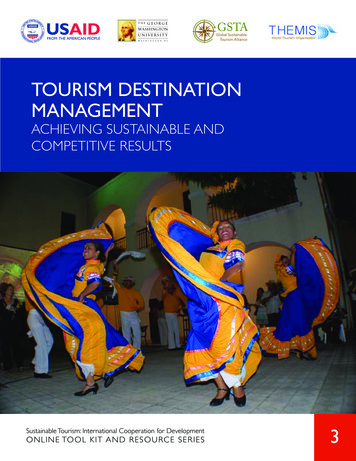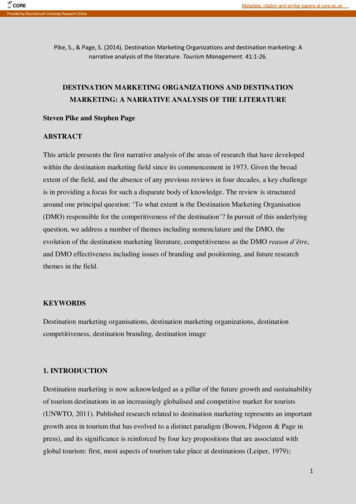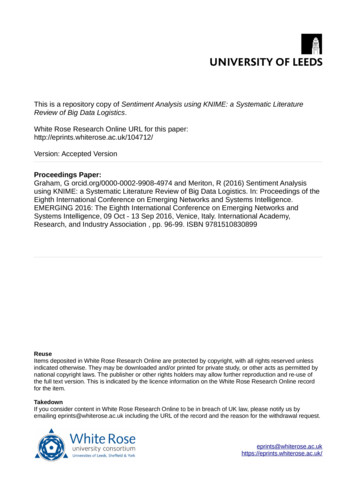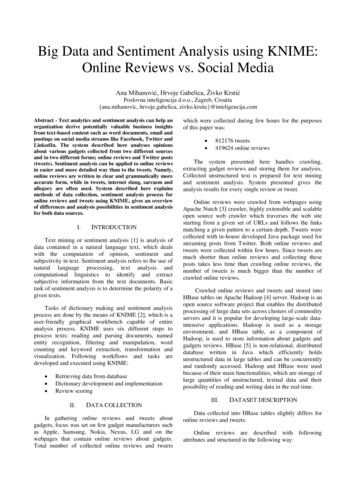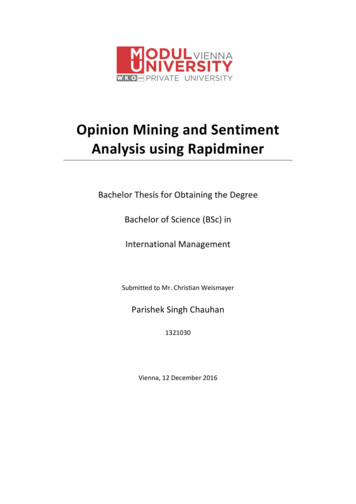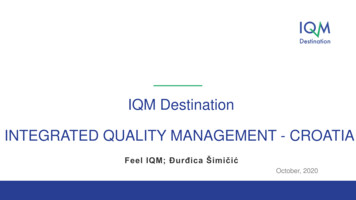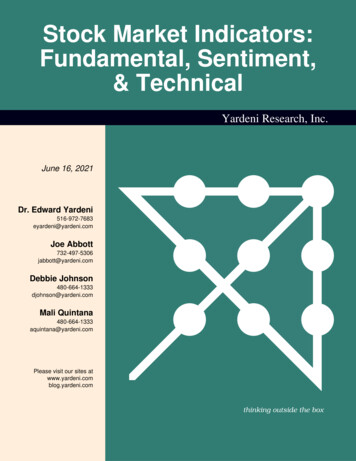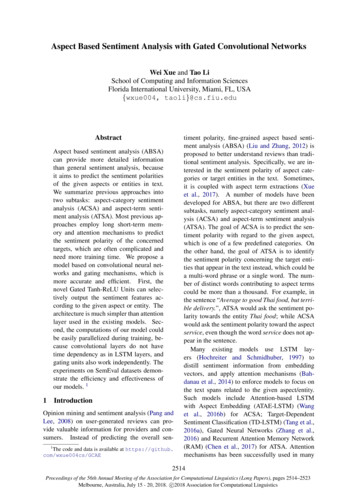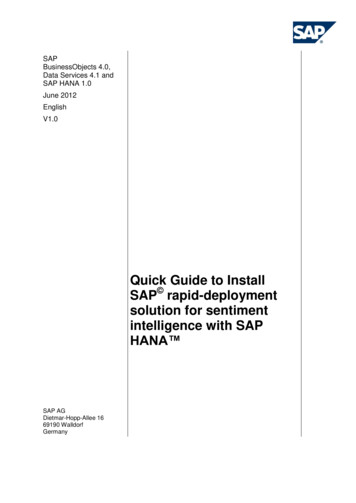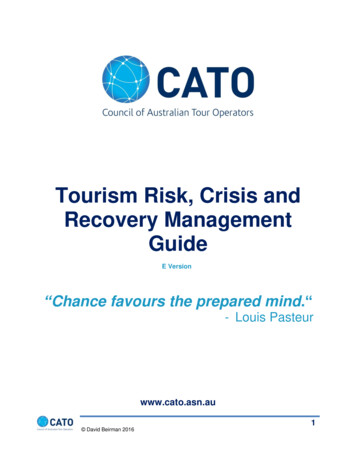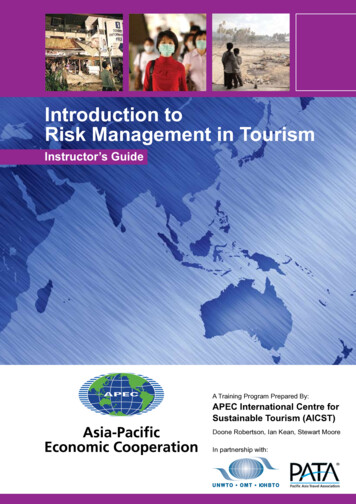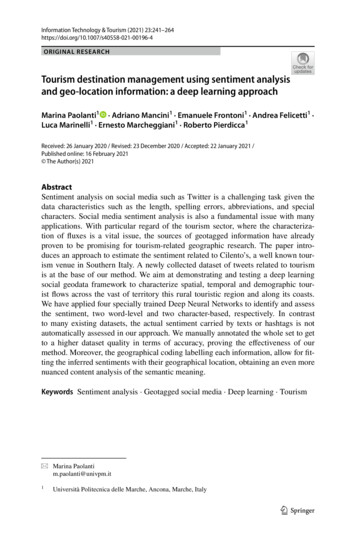
Transcription
Information Technology & Tourism (2021) 96-4ORIGINAL RESEARCHTourism destination management using sentiment analysisand geo‑location information: a deep learning approachMarina Paolanti1 · Adriano Mancini1 · Emanuele Frontoni1 · Andrea Felicetti1 ·Luca Marinelli1 · Ernesto Marcheggiani1 · Roberto Pierdicca1Received: 26 January 2020 / Revised: 23 December 2020 / Accepted: 22 January 2021 /Published online: 16 February 2021 The Author(s) 2021AbstractSentiment analysis on social media such as Twitter is a challenging task given thedata characteristics such as the length, spelling errors, abbreviations, and specialcharacters. Social media sentiment analysis is also a fundamental issue with manyapplications. With particular regard of the tourism sector, where the characterization of fluxes is a vital issue, the sources of geotagged information have alreadyproven to be promising for tourism-related geographic research. The paper introduces an approach to estimate the sentiment related to Cilento’s, a well known tourism venue in Southern Italy. A newly collected dataset of tweets related to tourismis at the base of our method. We aim at demonstrating and testing a deep learningsocial geodata framework to characterize spatial, temporal and demographic tourist flows across the vast of territory this rural touristic region and along its coasts.We have applied four specially trained Deep Neural Networks to identify and assessthe sentiment, two word-level and two character-based, respectively. In contrastto many existing datasets, the actual sentiment carried by texts or hashtags is notautomatically assessed in our approach. We manually annotated the whole set to getto a higher dataset quality in terms of accuracy, proving the effectiveness of ourmethod. Moreover, the geographical coding labelling each information, allow for fitting the inferred sentiments with their geographical location, obtaining an even morenuanced content analysis of the semantic meaning.Keywords Sentiment analysis · Geotagged social media · Deep learning · Tourism* Marina Paolantim.paolanti@univpm.it1Università Politecnica delle Marche, Ancona, Marche, Italy13Vol.:(0123456789)
242M. Paolanti et al.1 IntroductionThe proliferation of the Web 2.0 tools as well as the spread of social media in thelast years, is bringing a significant increase in the use of user-generated contents(UGC). In this context, sentiment analysis is now making its way with substantialgrowth in several domains such as marketing and finance. It is a branch of affective computing research (Poria et al. 2017) and this area is now widely recognizedas a new Natural Language Processing (NLP) line, which broadly analyses users’opinions, reviews or thoughts about topics, companies or experiences identifyingits sentiment (Liu 2015). Sentiment analysis has the aim of evaluating whether atextual item expresses a positive or negative opinion, in general terms or abouta given entity (Nakov et al. 2016). To get at the sentiment classification of textual items, a well-defined sentiment lexicon provides the list of sentiment wordsand phrases, each with an explicit sentiment score. Indeed, the sentiment lexiconsignificantly influences the performance of a lexicon-based Sentiment Analysis(Hogenboom et al. 2014). The sentiment lexicon is built from dictionary-basedand corpus-based methods; these latter furtherly divided into statistical-based andsemantics-based forms according to the specific techniques (Khan et al. 2016).Research efforts have been devoted to developing algorithms and sentimentanalysis methods, able to automatically detect the underlying sentiment of a text(Sun et al. 2017). Many companies are deploying these algorithms to make betterdecisions, understanding customers behaviour or thoughts about their company orany of their products (Valdivia et al. 2019).While several studies have examined various users’ reactions towards brandsor companies (Paolanti et al. 2017; Ghiassi et al. 2013), the sentiment related totourism at the destination level and its possible outcomes has not received muchattention from scholars. Tourism has both positive and negative economic, socialand environmental impacts on destinations. One of the main goals of sustainabletourism development is to minimize the negative social and ecological impacts ofvisitor flux, improving at the same time the experience of visitors and the quality of life of residents (Gursoy et al. 2019). Despite the potentials of sentimentanalysis to this end, exploiting the massive tourism reviews and posts produced,the recourse to this is limited since the manual and comprehensive extraction ofuseful knowledge from the studies is costly and time-consuming (Kim et al. 2017;González-Rodríguez et al. 2016).Currently, Twitter (http://twitt er.com/) represents one of the most popularsocial networking platforms. It allows people to express their opinions, favourites, interests, and sentiments towards different topics and issues they face in theirdaily life. The messages, namely tweets, are real-time (Alharbi and de Doncker2019). Twitter gives the possibility to access to the unprompted views of a broadset of users on particular products or events. Twitter has about 200 billion tweetsper year (corresponding to 500 million tweets per day, 350,000 tweets per minute,and 6000 tweets per second) (Alharbi and de Doncker 2019). There is also a needto automate the identification and extraction of the spatial information about tourist flows from tweets. Accurately identifying localized flood extent is difficult,13
Tourism destination management using sentiment analysis 243especially in urban areas, and social media can help with gathering and disseminating information. These are some of the reasons for the choice of Twitter as acase study in this research.Tourism tweets are informal and conversational. Thus, effective sentiment analysis techniques must be introduced to process such textual data. Furthermore, significant construction of a high-quality tourism-specific sentiment lexicon is ofgreat value. Most of the existing methods of Twitter sentiment classification applymachine learning algorithms, such as Naïve Bayes, Maximum Entropy classifier(Max. Ent.) and Support Vector Machines (SVMs) to build a classifier from tweetswith manually annotated sentiment polarity labels (Saleena 2018). In recent years,there has been a growing interest in using deep learning techniques, which canenhance classification accuracy, especially in cases when the amount of labelleddata is thousands of examples.Considering the motivations stated above, the research contributions of this manuscript are twofold. On one hand, we experimentally compare the performance ofstate of art deep learning methods to estimate the sentiment related to a well-knowntourism destination in Southern Italy. In particular, the sentiment is classified by fourspecially trained Deep Neural Networks (DNNs). The networks used are the onesproposed by Kim (2014); Kim et al. (2016) and Zhang et al. (2015), and these areword- and character-based. Four DNNs architectures are chosen by testing differentcombinations of parameters and taking into consideration the best one. The variable parameters tested are the maximum characters length of tweets and the size ofthe dictionary (for word-based DNNs) or alphabet (for characters-based DNNs). Onthe other, by exploiting geographical information, we show that deep learning architectures allows to infer, with a data-driven approach, spatial, temporal and demographic features of tourist flows. Indeed, recent research trends demonstrates thatthe combination of sentiment analysis and geo-location information can contributeto more efficient planning of tourism destinations (Yan et al. 2020). The approachhas been applied to a newly collected dataset of tourism-related tweets. The datasetas well as the implementation code, is publicly available at (https ://XXX.it/conte nt/datas et-tweet s-relat ed-cilen to, obscured for blinded purposes). In contrast to manyexisting datasets, the true sentiment is not automatically judged by the accompanying texts or hashtags. Still, it has been manually estimated by human annotators,thus providing a more precise dataset. Our approach yielded promising results interms of accuracy and demonstrated the effectiveness of the proposed method. Ourdataset is specific for the tourism domain. However, the models chosen are genericand are the best current state of the art text classifiers. Furthermore, these networkshave been tested with other datasets, in their reference papers: (1) Word-CNN (Kim2014): tested on 6 different datasets, most of them for sentiment analysis; (2) WordLSTM (Sutskever et al. 2014): tested on WMT’14 datasets; (3) Char-CNN (Kimet al. 2016): tested on English Penn Treebank dataset; (4) ConvNets (Zhang et al.2015): tested on 8 different datasets, with classes ranging from 2 to 14.The paper is organized as follows: Sect. 2 is an overview of the research status oftextual sentiment analysis; Sect. 3 introduces our approach, also describing the dataset and algorithms; final sections present results (Sect. 5) and conclusions (Sect. 6)with future works.13
244M. Paolanti et al.2 Related worksSeveral methods are available in the literature that uses classifiers for Twitter sentiment analysis, with the main purpose of detecting polarity. In literature there aremany reviews of approaches which show noteworthy differences from both methodsand data sources standing point. Most existing studies to Twitter sentiment analysiscan be divided into supervised methods (Saif et al. 2012; Kiritchenko et al. 2014; DaSilva et al. 2014; Hagen et al. 2015; Jianqiang and Xueliang 2015; Jianqiang 2016)and lexicon-based methods (Paltoglou and Thelwall 2012; Montejo-Ráez et al.2014). Supervised methods are based on training classifiers (such as Naive Bayes,Support Vector Machine, Random Forest) using feature combinations such as PartOf-Speech (POS) tags, word N-grams, and tweet context information features (suchas hashtags, retweets, emoticon, capital words, etc). Lexicon-based methods determine the overall sentiment tendency of a given text by utilizing pre-established lexicons of words weighted with their sentiment orientations, such as SentiWordNet(Baccianella et al. 2010) and WordNet Affect (Miller 1995). They represent a pairof knowledge-based techniques, based on the resources of semantic knowledge todetermine the polarity of feelings expressed by peers. The analysis of tweets lookingfor underlined feelings, the “sentiment” sent through the texts, is based on the identification of specific emotional words from a defined lexicon. The ease of applicationand accessibility gives the popularity of these methods. However, their performancedepends on a comprehensive basis and a rich representation. Other methods exploitstatistical approaches (Cambria and White 2014) but, despite their widespread usein the scientific environment, show performance strongly influenced by the availability of large training sets (Cambria and White 2014).Recently deep learning methods (Tang et al. 2014), well established in machinelearning (Bengio 2009; LeCun et al. 2015), are becoming most popular by replacingshallow feature representations as for example bag-of-words combined with supportvector machines, used in the past as the primary methods for identifying and analyzing textual sentiment analysis. There are three main methods used to classify sentiment: Support Vector Machine (SVM), Naïve Bayes and Artificial Neural Network(ANN), and deep learning algorithms. The use of ANN comes with a more significant computational cost but better results than the other two approaches. SVM andNaïve Bayes methods have limited performance but with a reduced computationalcost. In (Kim 2014), the author reports some experiments using a model based onConvolutional Neural Networks (CNN) to extract features and detect automatic sentiment analysis of Twitter messages. Experimental results on different datasets havedemonstrated that the classification performance are improved by using CNNs. Anew deep neural network model has been introduced by Santos et al. (2014) thatimplements Twitter sentiment analysis by using information from character-level tosentence-level and obtaining high accuracy of prediction. In Jianqiang et al. (2018),the authors use a convolution algorithm to train a deep neural network for improvingthe accuracy of Twitter sentiment analysis. The method uses statistical characteristics and semantic relationships between the words of each tweet.13
Tourism destination management using sentiment analysis 245The automatic sentiment evaluation has proved to play an important role evenfor tourism (Moreno-Ortiz et al. 2019); in this sector, the machine learning methods mainly used are based on SVM and Naïve Bayes approaches (Kirilenko et al.2018; Alaei et al. 2019). Moreover, many of these works compare the performance among different machine learning methods. The work of Ye et al. (2009)compares the results obtained using three other machine learning methods: SVM,Naïve Bayes and k-Nearest Neighbors (k-NN) algorithm, considering reviews onseven famous destinations in Europe and in the United States, they obtained thebest results with SVM classifier. In another work (Zhang et al. 2011), comparing only SVM and Naïve Bayes algorithms, the best results are obtained with aNaïve Bayes, obtaining a high accuracy in the sentiment classification of restaurant reviews.There are other works that use lexicon-based approaches for tourist sentimentanalysis. Serna et al. (2016) considered tweets concerning Summer and Easterholiday and used WordNet algorithm (Miller 1995) to extract emotions fromtweets. SentiWordNet (Baccianella et al. 2010), an evolution of WordNet, hasbeen successively used to classify sentiment in a tour reviews forum (Neidhardtet al. 2017).However, few works focus on automatic sentiment analysis in tourism considering texts obtained from social networks as Twitter (Kirilenko et al. 2018). In thetourism domain Chua et al. (2014, 2016) have demonstrated how the analysis ofgeotagged social media data yields more detailed spatial, temporal and demographicinformation of tourist movements in comparison to the current understanding oftourist flow patterns in the region. The joint exploitation of sentiment and geo-information revealed to be a powerful instrument in case of critical events, like in Gonzalo et al. (2020) and for disaster management (Wu and Cui 2018); notwithstanding,a deeper understanding of its benefits for tourism destination planning is necessary,motivating the experiments showed in the following.As stated in Adwan et al. (2020), the approaches adopted for Sentiment Analysis of Twitter data vary from lexicon-based and machine learning to graph-basedapproaches.The lexicon based method uses sentiment dictionary with opinion words andmatch them with the data to determine polarity. Lexicon based approach can further be divided into two categories: Dictionary based approach (based on dictionarywords i.e. WordNet or other entries) and Corpus based approach (using corpus data,can further be divided into Statistical and Semantic approaches). Machine learningbased approach uses classification technique to classify text into classes, and methods like Naïve Bayes (NB), maximum entropy (ME), and support vector machines(SVM) have achieved great success in sentiment analysis. Recently, the prevalenceof Deep Learning models, which are a subset of Machine Learning, are proven tobe of high level task, especially for automatic analysis of Twitter data (Lim et al.2020). Based on the pros and cons highlighted in Table 1, the approach adopted inthis paper is based on Deep Learning for its ability to deal with a huge amount ofdata. Moreover, the DNNs can provide a lot of information by extracting the mostrelevant features. In this domain this aspect is fundamental, since we deal with asubjective task such as the sentiment.13
13Cannot deal with domain andNeeds a guideline and knowncontext specific orientationsaspects to work. Based on Wordnet databaseWeaknessesReviews with a lot of noise (irrel- The correspondence between identified clusters and the actual aspectsevant words for the subject ofor ratings is not explicit (genthe review) are often assigned aeral drawback for unsupervisedneutral score because the methodmodels)fails to detect any sentimentProbabilistic assumption that asentiment and its rating are interdependent. Overcomes a wellknown problem of other methodswhere a positive sentimentexpressed with a word having anegative connotation is misinterpreted (e.g., low price)The main advantages are thelexicon/learning symbiosis, thedetection and measurement ofsentiment at the concept leveland the lesser sensitivity tochanges in topic domainIt is more understandable and canbe easily implementedThey take into consideration boththe strength of an opinion aswell as the the relevance of thefeature the opinion is about forthe general customerStrengthsCombines two or more approaches Represents tweets in graph structures, along with words, hashtagsfor Twitter sentiment analysisor userssuch as combining machinelearning and lexicon-basedapproachesLeverages a list of words annotated by polarity or polarityscore to determine the opinionscore of a given textGraph-basedUses classification technique toclassify text into e 1 Comparative overview table with the key differences between the proposed frameworks for Twitter Sentiment analysis246M. Paolanti et al.
Automated Sentiment Analysis inTourismTable 1 (continued)A DWWP system consisting ofLexicon-based sentiment analysis System uses hybrid approachdomain-specific words detection(lexicon and machine learningalgorithm designed with the(DW) and word propagation (WP)based techniques) for analysingmain focus on real time Twitteris proposed. DW deals with thesentiment in the domain of travelcontent analysis. The algorithmnegligence of user-invented newand tourism (Phoo and Naw)consists of two key components,words and converted sentimentnamely sentiment normalisationwords by means of AMI (Assemand evidence-based combinationbled Mutual Information). Thisfunction, which have been usedWP approach incorporates manuin order to estimate the intensityally calibrated sentiment scores,of the sentiment (Jurek et al.semantic and statistical similarity2015)information, which improves thequality of sentiment lexicon incomparison with existing datadriven methods (Li et al. 2018)Graph-basedSupport Vector Machine (SVM)and Nave Bayes are the mostpopular in tourism-relatedsentiment analysis (Claster et rism destination management using sentiment analysis 24713
248M. Paolanti et al.3 Materials and methodsIn this section, the textual sentiment analysis framework, as well as the dataset usedfor its evaluation, are introduced. Cilento is a well-known tourist venue located inSouthern Italy, the vastness and the orthographic complexity of the area always arethe strongest and the weaken points, at the same time, of this tourism venue. In thispeculiar context, that since many years the local administrations struggled for agreeing on best fitting regional tourism strategy, to boost bold development and cohesion.Since late 2013 we have been engaged in a national project (TOOKMC: Transfer OfOrganized Knowledge Marche-Cilento) funded by European and state agencies tofoster the exchange of best practices in sustainable tourism between developed andunder-developed regions in Italy. For the evaluation, trained DNNs have been used,and they have been comprehensively evaluated on a dataset of tweets collected forthis work, related to Cilento. The framework shown at Fig. 1. The following subsections, provide further d
Tourism destination management using sentiment analysis especially in urban areas, and social media can help with gathering and dissemi-nating information. These are some of the reasons for the choice of Twitter as a case study in this research. Tourism tweets are Author: Marina Paolanti, Adriano Mancini, Emanuele Frontoni, Andrea Felicetti, Luca Marinelli, Ernesto March.
